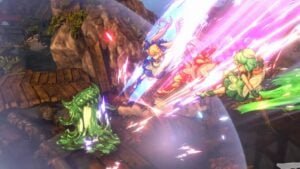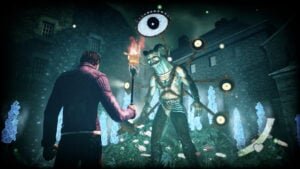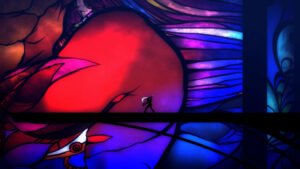Genndy Tartakovsky has worked on some of TV’s most influential cartoons.
From Dexter’s Laboratory to Samurai Jack he has built a reputation for crafting complex and engaging television. With the last season of Samurai Jack he got to spread his wings, and tell a more adult story within the universe he created to overall critical and fan acclaim. Now he is pushing the envelope once again with his new cartoon Primal.
Set in a fictional past, Primal follows a man, surrounded by tragedy as he makes friends with a dinosaur who mirrors his suffering. Together they venture into a world filled with danger, and turmoil to try and survive with nothing but each other. Taking cues from the dialogues scenes in Samurai Jack, Primal is a new take on what mainstream animation can be.
In a phone interview, Genndy Tartakovsky took the time to chat with CGMagazine about his new show. In a candid discussion, he dives into Primal, along with what the process was like bringing it to reality. From concept to the unique take on composition and music, Tartakovsky gives an inside take at what fans can expect when they dive into Primal, coming to Adult Swim in the US and Canada. Genndy Tartakovsky’s Primal airs as a special five-night event beginning Monday, October 7 at Midnight on Adult Swim.
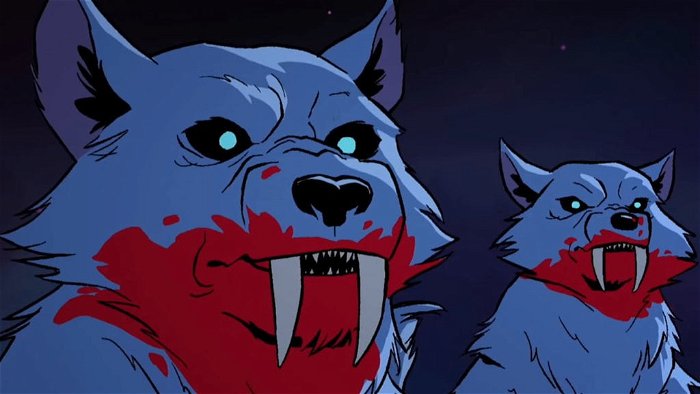
CGMagazine: First, I’d love to know how Primal got started. How did you come up with the idea, and how did you make it from concept to reality?
Genndy Tartakovsky: Well, basically, it started probably about eight years ago or so. And it initially started as a, just like a normal kids show with a little caveman kid riding a little T-Rex, and they would have adventures and stuff. But the show never kind of got going. And I always believe in a very organic process. I never got excited about the story. I like
that idea, but nothing ever happened with it, so I kind of put it away. And then later, we started doing the last season of Samurai Jack, and at the time, we were doing these sequences with no dialogue, and it was for adults, and they got a really strong reaction.
Basically, the things from Samurai Jack, the last season, that people reacted to the most were these big, visceral action segments or no dialogue sequences, which we’ve always had in the old show, but because this was for adults, there was more to it. More drama, more tension, etc. And so I thought, “well, I wonder if I could make a whole series just made up of these scenes with no dialog.” And then I remembered I had this caveman and dinosaur idea. Then I aged them up, came up with this more dramatic tone, a basic story of survival between these two unlikely characters. And then it really started to come together. We realized, yeah, then the story ideas were popping up super quick. So I knew in my gut that this was the right way to go with it.
CGMagazine: Now, I do want to quickly touch on the fact that this is a show with no dialogue. It is a show of it’s all about the reactions, the looks, the sound. How was that to script? And how did you ensure you’re getting across that emotional message that you do manage, with no dialogue?
Genndy Tartakovsky: I mean, we’ve been at it to try to learn how to tell stories, for almost 30 years or so. It’s part of the experience, and through my career, I’ve done a lot of these types of sequences, although not to this level and I’m not a big fan of one-liners. So in the action scenes that we used to do, there wasn’t a lot of talking, so it was a very comfortable place to go. You kind of have to start filling in the gaps. And so the expressions have to be very specific, and because there’s no dialogue, the subtleties became even more important. We’re in general, like a normal TV animation, if somebody is talking, you can kind of have a couple of gestures, and you’re out of it because everybody’s listening to the radio show.
But with this, everything had to be heightened. I was also trying some new philosophies and timing, where I would linger more in the scene. Because through everything that I’ve done, I always felt like I’m shortchanging the music because I always wanted to give the scene an extra 3 seconds so the music can really make a statement. And for this, I tried to be really dedicated to the idea that the scene is going to be 20 seconds long. But it’s going to be tortured to watch. Once we lay the music over it, it’s going to breathe like crazy. And sure enough, it’s something that you tell yourself all the time, but you can’t imagine that you’re going to have the same 20 seconds. And certainly we’ve seen longer and it becomes more cinematic that way too. If you think about live-action, they just shoot stuff. There are always interesting things to look at because it’s real, but we have to manufacture every shot. So you’re giving it a chance to breathe, and what that does is it makes you feel it more. That was one of the big goals in the show is to change the sensibility of the timing, let things linger, let it breathe. Hopefully it’s not boring, but in fact, you’re more invested. Because now you’re truly feeling it more.
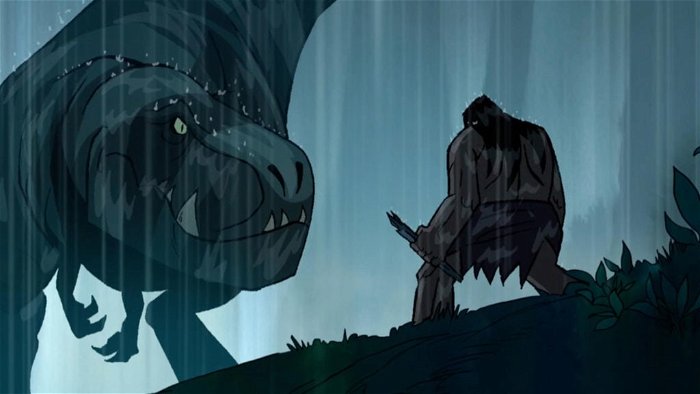
CGMagazine: How did the raw visual language at play come to be within Primal?
Genndy Tartakovsky: It was the goal. Once I had the title of the show, I knew I wanted everything to relate to it. And so the show is actually very, very beautiful. The colour palette is very lovely. It’s the magic of Scott. Scott Wills is our production designer, and Scott has a very unique colour palette. So we would talk about the mood like is it going to be sombre is it going to be dark, and then he would just go off and figure out a way how to do the lighting to the end the colour to emphasize what the mood is and so then you have everything firing to tell the same story.
Maybe it is because of the lack of dialogue that everything feels heightened and the story is intense, and it is very select when he’s climbing the mountain to commit suicide. It’s hot pink, and you start to really feel the intensity. It’s all been part of filmmaking forever. It’s not like we’ve invented it, it’s just where we’re constructing stories where all those elements are really focused on and they shine. Because he’s not going to say “I’m sad, I’m going to jump off this cliff,” we have to do it. And because it’s for adults, we’re trying not to be too obvious. As fans of cinema and film and TV, you can put two and two together and understand how his journey is going and feel within starting to understand what he’s going to do.
CGMagazine: Being on Adult Swim rather than standard network television, doe it allows you more freedom to do more interesting things? Did you feel that there was anything you couldn’t do with the show? And did you ever have to rein it back?
Genndy Tartakovsky: Um, no, I think we’ve pretty much had 100% freedom. There are definitely some things where we’re violence wise or more gore, we’re walking on the line. There wasn’t a lot of sexual things that we were doing. So I wasn’t worried too much about that. I mean, animation for adults now is way beyond anything I could have ever imagined it would have been 10 years ago. So I think the reins are kind of backed off. We just went for it. And also it wasn’t really an issue because I’m not out to do the most violent thing I’ve ever done. I’m not a violent person. I actually don’t get off on violence and gore. If it suits the story, then I do it.
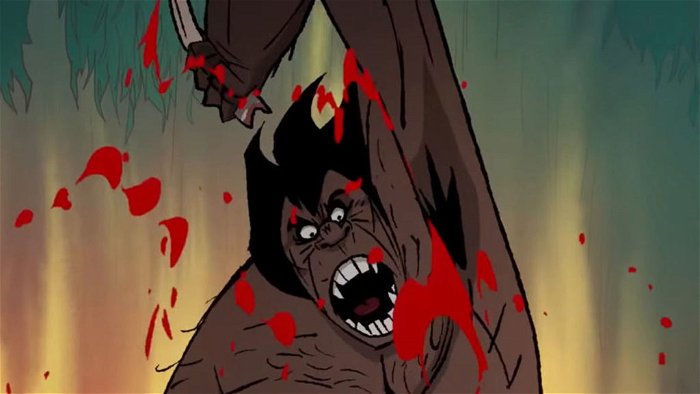
CGMagazine: You mentioned Samurai Jack being something that a lot of people kind of latched on to and this show seems to take visual style very similar to that show. Was that intentional? Did that just work out naturally? How did that all kind of come to be?
Genndy Tartakovsky: Well, it’s kind of like everything that we’ve done. There’s sensibility to it, there’s a graphic sensibility. There’s a sensibility to the way I direct or compose stories, I don’t want to say it is my style so much, but it’s what I like. And so I tried to recreate it. So there’s no hiding it, even as much as we wanted too. We wanted not for people to say something like, “Oh, it’s just Caveman Jack or whatever.” But the reality is, we do what we do, and it carries over to me. In a way, it’s a compliment, because I always feel like the signature of a director is when you can watch a scene or a sequence, and go “Oh, that’s got to be Hitchcock” or whatever. Not that I’m at that level. But he has a specific style. You want to do something that other people can’t do, or don’t want to do. And it’s what makes a good director, I think.
CGMagazine: Could you discuss how you came up with some of the iconic scenes audiences will see when they dive into Primal?
Genndy Tartakovsky: It’s hard to answer because it’s not systematic. It’s not formulaic, it’s kind of just from your gut. First of all, when I leave a movie or TV show, I want to close my eyes and think of shots that stick out. Nothing is worse to me than walking out of a movie and not even remember anything specific from it. Because of our colour sensibility, and our read, we tried to do a read where the characters are dark, and the backgrounds are light, or the characters are light, and the backgrounds are dark. So you have this very stark contrast. And it defines it and it helps in its iconic nature. But the rest of it is really it’s just from the gut. I don’t think if I was ever to teach a class, I could tell you, well, if you do this, this and that is going to equal success. That’s the whole complexity and excitement of storytelling, there’s no one way to do it.
It usually requires somebody’s point of view to tell a story to be honest and sincere. I think that’s what it is, it’s just there is no process, so to speak. It’s just there’s an emotion that I’m trying to get to. And this is the way I can stage it in the simplest way and the most unique way. Moviemaking is a collaborative effort of all these different elements, and once they all come together, they’re all telling the same story. That’s when you click onto something. But if one of those elements or a couple of elements are off, all of a sudden, it’s not as crisp. And I think after doing all these visceral sequences throughout my career, you start to really learn what’s what and what really works and what doesn’t.
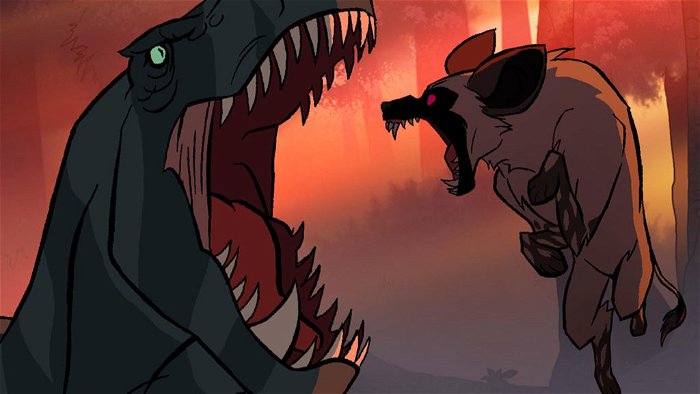
CGMagazine: Now just wrap up. Is there anything people you want people to take away as they go into watch Primal?
Genndy Tartakovsky: I think they should take away that they are going into something intense and fun and emotional. It’s brutal. Every scene, every episode, is unique to itself. There are no two episodes that are the same. I think that’s what’s going to catch people by surprise. At the same time, it will have the same elements. As the stories unravel, we see their emotional bond growing, and there’s so much more to it than just the violence. I think it’s a very great reason to tune it.
You can read the full interview in CGMagazine Issue #38 avalable digitally and at your local magazine seller.


